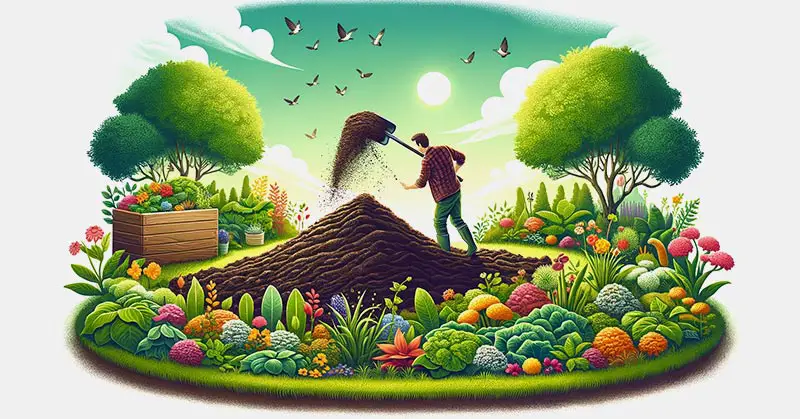Compost on Top of Soil
Placing compost on top of soil is a highly effective, natural method to enrich your garden’s soil. This process involves spreading a layer of organic compost over the soil surface. The compost then slowly integrates into the soil, improving its quality, structure, and nutrient content. It’s a straightforward, eco-friendly way to boost plant health and promote sustainable gardening.
But why is this method so beneficial, and how exactly does it transform your garden? In this article, we’ll dive into the remarkable journey of how a simple layer of compost can revitalize your garden’s soil, making it a haven for robust plant growth and a flourishing ecosystem. We’ll explore the science behind it, the step-by-step process for beginners, and the remarkable benefits your garden will experience.

Benefits of Applying Compost to Garden Soil
When it comes to gardening, the use of compost as a top layer on soil is a game-changer. Not only is it an easy and natural method, but the benefits it brings to your garden are numerous. In this section, we’ll explore why spreading compost on your garden soil is one of the best things you can do for your plants.
List of Benefits:
- Enhanced Soil Structure: Compost improves soil aeration and drainage while retaining moisture – essential for healthy plant roots.
- Nutrient-Rich Soil: It acts as a slow-release fertilizer, providing essential nutrients like nitrogen, phosphorus, and potassium.
- Natural Pest Control: Healthy soil from composting can help suppress plant diseases and reduce pest infestations.
- Eco-Friendly: Compost reduces the need for chemical fertilizers, promoting a more sustainable and environmentally friendly garden.
How to Spread Compost on Top of Your Soil
Applying compost to the top layer of your garden soil is a straightforward process, but doing it correctly can significantly enhance its effectiveness. Here’s a step-by-step guide to ensure you’re getting the most out of your compost.
Guide:
- Select Quality Compost: Choose well-decomposed, organic compost that’s free of weed seeds and pathogens.
- Timing: The best time to apply compost is in early spring or fall.
- Preparation: Remove any large debris and weeds from your soil.
- Application: Spread a 2-3 inch layer of compost evenly over your soil.
- Integration: While not necessary, lightly mixing the compost into the top layer of soil can speed up integration.
- Watering: Give your garden a light watering to help settle the compost.
Composting Techniques for Different Soil Types
Different soil types have unique needs, and the way you apply compost can be tailored to meet these requirements. Whether you have sandy, clay, or loamy soil, composting can be adapted to enhance soil quality effectively.
| Soil Type | Composting Technique |
| Sandy Soil | Apply a thicker layer of compost to increase moisture retention. |
| Clay Soil | Use compost to improve drainage and break up dense soil. |
| Loamy Soil | A balanced approach is best, maintaining the natural fertility of the soil. |
Using Compost as a Top Dressing for Soil Health
For enthusiasts of organic gardening, incorporating compost as a top dressing on garden soil is an invaluable practice. This section will highlight how this simple yet effective method can lead to a healthier, more vibrant garden naturally.
Key Points:
- Sustained Soil Health: Regularly adding compost on top of garden soil replenishes organic matter, vital for maintaining soil health.
- Reduced Chemical Use: Compost reduces the need for chemical fertilizers and pesticides, aligning with organic gardening principles.
- Enhanced Microbial Activity: The organic matter in compost promotes beneficial microbial activity in the soil, crucial for nutrient cycling.
The Science Behind Compost and Soil Fertility
Understanding the scientific principles behind the use of compost on garden soil can offer deeper insights into its effectiveness. This section delves into the science of how compost works to enhance soil fertility.
Scientific Explanation:
- Nutrient Release: Compost gradually releases nutrients into the soil, providing a steady supply that plants can absorb over time.
- Soil Structure Improvement: It enhances soil structure, making it more friable and hospitable for root growth.
- Water Retention and Drainage: The organic matter in compost improves water retention in sandy soils and drainage in clay soils.
Reducing Waste with Compost on Soil
Eco-friendly gardening practices are increasingly important in our efforts to live sustainably. In this section, we explore how using compost on top of soil not only benefits your garden but also contributes to a healthier environment.
Environmental Benefits:
- Waste Reduction: Composting converts kitchen scraps and yard waste into valuable soil amendments, reducing landfill waste.
- Carbon Sequestration: Composting helps sequester carbon in the soil, combating climate change.
- Biodiversity: A healthy, compost-rich soil supports a diverse range of organisms, from microorganisms to earthworms, enhancing garden biodiversity.
Comparing Compost with Other Soil Amendments
While compost is a fantastic option for enriching garden soil, it’s not the only soil amendment available. In this section, we compare compost with other common soil amendments, helping you understand when and why to use each.
| Soil Amendment | Benefits | Best Used For |
| Compost | Improves soil structure, nutrient-rich, eco-friendly | All-purpose, especially for improving overall soil health |
| Fertilizers | Quick nutrient supply | Specific nutrient deficiencies |
| Mulch | Retains moisture, weed control | Top layer for moisture and temperature regulation |
| Manure | High in nutrients | Nutrient-rich amendment, but requires proper composting to avoid pathogens |
Seasonal Tips for Composting
The effectiveness of spreading compost on top of soil can vary with the seasons. This section provides seasonal tips to maximize the benefits of composting throughout the year.
Seasonal Guide:
- Spring: Apply compost to prepare beds for planting. It’s a great time to mix compost into the soil.
- Summer: Use compost as a mulch to help retain moisture during hot months.
- Fall: Apply compost to protect plants over winter and enrich the soil for the next year.
- Winter: Prepare and stockpile compost for use in the coming spring.
Compost and Soil pH: Balancing Your Garden’s Needs
The pH level of your soil is crucial for plant health, and compost can play a significant role in balancing it. This section explores how compost affects soil pH and what this means for your garden.
Key Points:
- Neutralizing Effect: Compost generally helps in neutralizing soil pH, making it more suitable for a wide range of plants.
- Organic Matter and pH: The decay of organic matter in compost can gradually alter soil pH.
- Testing and Monitoring: Regular soil pH testing is recommended to understand how your composting practices affect your soil over time.
FAQs of Compost pn Top of Soil
Q: Can I use compost on top of potting soil for indoor plants?
A: Absolutely! Adding a thin layer of compost to your indoor potting mix can provide nutrients and improve the soil’s quality, just as it does in outdoor gardens.
Q: How often should I renew the compost layer on my garden beds?
A: Generally, refreshing the compost layer once or twice a year is sufficient. Many gardeners prefer to do this in the spring and/or fall.
Q: Is there a risk of over-composting my garden soil?
A: Yes, over-applying compost can lead to excessively nutrient-rich soil, which can be harmful to plants. It’s important to apply compost in moderation and according to your soil’s needs.
Q: Can composting help in controlling soil erosion?
A: Yes, compost can help reduce soil erosion. Its ability to improve soil structure and water retention helps keep the soil in place, especially on slopes or in areas prone to erosion.
Q: Will adding compost to my soil attract pests?
A: Properly composted material is unlikely to attract pests. However, it’s important to avoid adding meat, dairy, or oily foods to your compost to minimize the risk of attracting unwanted animals.
Q: Can I apply compost to my lawn?
A: Certainly! Spreading a thin layer of compost over your lawn can improve soil health and grass vigor. This practice, known as top-dressing, is beneficial for lawn care.
Q: How does compost affect the water requirements of my plants?
A: Compost improves soil’s moisture retention capacity, which may reduce the frequency of watering needed. However, regular monitoring is still important, as water requirements can vary based on plant type and weather conditions.
Q: Are there specific types of compost better suited for certain plants?
A: Yes, different compost types can suit different plants. For example, compost made primarily from leaves is great for woodland plants, while compost with more manure content might be better for heavy-feeding vegetables.



